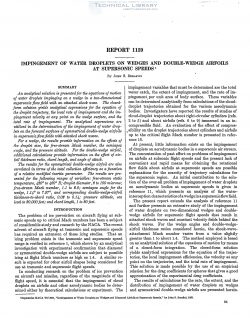naca-report-1159
- Version
- 179 Downloads
- 2.65 MB File Size
- 1 File Count
- November 2, 2016 Create Date
- November 2, 2016 Last Updated
National Advisory Committee for Aeronautics, Report - Impingement of Water Droplets on Wedges and Double Wedge Airfoils at Supersonic Speeds

An analytical solution is presented for the equations of motion
of water droplets impinging on a wedge in a two-dimensional
supersonic flow field with an attached shock wave. The dosed—
form solution yields analytical expressions for the equation of
the droplet trajectory, the local rate of impingement and the im-
pingement velocity at any point on the wedge surface, and the
total rate of impingement The analytical etpressions are
utilized in the determination of the impingement of water drop—
lets on the forward surfaces of symmetrical double—wedge airfoils
in supersonic flow fields with attached shock waves.
For a wedge, the results provide information on the ejects of
the droplet size, the free-stream Mach number, the semiapece
angle, and the pressure altitude. For the double-wedge airfoil,
additional calculations provide information on the eject of air-
foil thickness ratio, chord length, and angle of attack.
The results for the symmetrical double-wedge airfoil are also
correlated in terms of the total collection efiiciency as a function
of a relative modified inertia parameter. The results are pre~
sented for the following ranges of variables: free-stream static
temperature, 420° to 460° 1?; droplet diameter, 2 to 100 microns;
free-stream Mach number, 1.1 to £0; semiapem angle for the
wedge, 114° to 737°, and corresponding double-wedge-aiifoil
thickness-to-chord ratio, 0.0.9 to 0.14; pressure altitude, sea
level to 30.000 feet; and chord length, 1 to 20 feet.
The problem of ice prevention on aircraft flying at sub—
sonic speeds up to critical Mach numbers has been a subject
of considerable study and research by the NACA. The recent
advent of aircraft flying at transonic and supersonic speeds
has required an extension of these icing studies. That an
icing problem exists in the tmnsonic and supersonic speed
range is verified in reference 1, which shows by an analytical
investigation with experimental confirmation that diamond
or symmetrical double-wedge airfoils are subject to possible
icing at flight Mach numbers as high as 1.4. A similar re-
sult is expected for other airfoil shapes being considered for
use at transonic and supersonic flight speeds.
| File | Action |
|---|---|
| naca-report-1159 Impingement of Water Droplets on Wedges and Double Wedge Airfoils at Supersonic Speeds.pdf | Download |
Comment On This Post